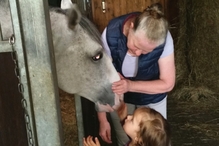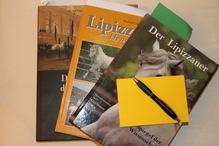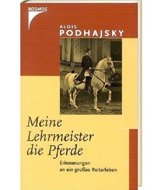Background
Character of a lipizzan

Stud Book of Origin

Definition of Breeding Characteristics
With regard to selection, tradition and culture, the Lipizzaner breed is one of Europe’s oldest horse breeds. The phenotype of the Lipizzaner breed is directed for general use and has proven to be especially suited for classical horsemanship (High School – Haute École) and for carriage driving.
- The Lipizzaner is very expressive, he has a noble posture, the overall conformation is harmonious, the frame more rectangular than square. Ideally, the adult horse should measure between 153 cm and 158 cm. The head is expressive with large, black eyes, a wide, slightly curved forehead, finely modelled lower jaw, strong cheeks with sufficient freedom, straight or slightly convex nose line.
- In keeping with the requirements of the Baroque, the strong and highly set neck has an arched main line and erect posture.
- The main line flows with moderately high and long withers. The shoulders are strong and sufficiently long and should be set at an angle between 50° and 65° to the proportionately long upper arm. The chest should be deep and wide.
- The back is wide, muscular and compact, the haunches are strong.
- The croup should be round, strong and have a harmonious tail root.
- The horse should have relatively short, strong, dry legs with clear tendons, strong joints and hard, correctly formed hooves.
- The high knee action is typical and important and contributes towards the elegance, harmony and beauty of the parade step.
- The walk is energetic and bouncy, with a long stride. The hindleg bears the weight and is therefore a prerequisite for the good collection of the Lipizzaner breed.
The traditional grey factor is dominant. All colours are accepted. The Lipizzaner is characterized by his hardiness, stamina, temperament, frugality, willingness to learn, obedience, and good nature.
Books

Book reviews

Lipizzaner Hengststämme
Lipizzan studlines
This book comprises a whole bunch of valuable information about the history of the oldest surviving breed from baroque times. It describes the development of the breed based on historical sources.

Der Lipizzaner im Spiegel der Wissenschaft
The lipizzan from a scientific perspective
A compilation of the results of the European ❝Inco-Copernicus❞ project: scientific research dedicated to the Lipizzan as the oldest breed worldwide.

450 years Spanish Riding School

Xenophon
The art of Riding – greek and german by Dr. Klaus Widdra

Meine Lehrmeister die Pferde
My horses were my teachers
The former head of the Spanish Riding Schhool in Vienna Alois Podhalski describes his career

Brother Mendel's Perfect Horse
Man and Beast in an Age of Human Warfare

Auf den Spuren der Lipizzaner
On the lipizzan trail
Heinz Nürnberg: Auf den Spuren der Lipizzaner

Gesunde Pferdefütterung
Healthy Horse Feed
Hans-Peter Karp has been connected with horses since his childhood days. Consequently he studied Agricultural Sciences and graduated on the topic of ❝Mineral Metabolism in Growing Thoroughbred Horses❞. As Managing Director of a great manufacturing company for horse feed, his vision is an individual food for every horse, tailored to their taste preferences. This book describes the basics of horse feeding and gives advice on how certain health problems can be remedied by appropriate feeding.
History of the Lipizzan Breed

History of the Lipizzan Breed
Archduke Karl of Inner Austria laid the foundations for the breeding of Lipizzan horses. In 1580 he founded a stud in the tiny village of "Lipitza". It was a barren area in the Karst mountain range. Under this hard conditions he wanted to raise beautiful, courageous, industrious and durable horses for the imperial court.
As was stated in 1689 by the historian, Johann Weichard Freiherr von Valvasor, in his document "Glory to the Duchy Krain". The language is quite ancient German, so here just a brief summary:
in 1580 a stud was founded at the Karst in the village Lipitza. There shall be raised the very best horses for the imperial court. These are the choicest horses one can find. They will walk and graze upon hard stones were few grass grows. As, according to the ancient roman writers, barren countries house the most valiant inhabitants, so do meager pastures raise the bravest, most durable and industrious horses.
At that time courts all over Europe craved for the so called "Spanish Horses" with lively movements and a natural tendency for collected movements on the ground and with bold jumps in the air. The importation of such horses was not only very expensive but also involving heavy losses.
Therefore the Archduke decided to breed those horses at a stud of his own. When he first brought the stallions and mares from Spain to Lipitza, it was not certain at all that the Spanish horses could cope with the harsh environment of the Karst. But the strict selection associated with the environmental conditions developed a tough and frugal type of horse. It was named "Karster Race". Only since the First World War these horses are known as "Lipizzaner".
During the following years more studs were founded to satisfy the great demands of the imperial court and more horses of Spanish, Neapolitanish and Danish breed were bought and integrated into the breed.
The history of the Lipizzan breed is closely connected with the Austrian Imperial Court. Again and again their welfare was endangered by wars. Several times the herd had to be evacuated. But the importance of the horses to the court ceremonial as well as the continuing use at the Spanish Riding School ensured the survival of the Lipizzans until the end of World War I.
Since then the Lipizzan breed has to fight for its survival. There was hardly any exchange of stallions and mares between the various studs. Each stud was now run separately under their own national management. Especially the "Iron Curtain" prevented an exchange of stallions and mares. The fall of the "Iron Curtain" and the founding of the Lipizzan International Federation (LIF) opened new opportunities for this old breed by exchanging breeding animals.
Already in 1915 the Lipica herd had been moved to Laxenburg near Vienna and to the Kladrub stud. Since 1920 part of this herd has found a new home in the Piber stud. Piber has been an imperial stud since 1789 and there the original studbook of the Lipizzan breed will be continued.

